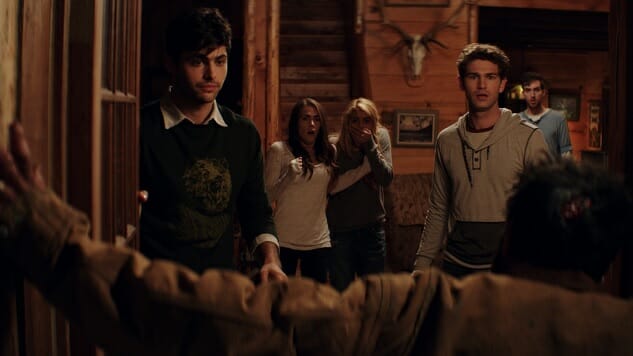Horror remakes happen all the time. They’re practically a genre tradition. Think The Blob ’88, or Invasion of the Body Snatchers ’78, or John Carpenter’s masterpiece The Thing (which itself was subject to remaking in 2011). You can even go back as recently as 2015’s Poltergeist, 2013’s Carrie or the Japanese horror remake trend of the early to mid 2000s, which saw titles like The Ring and Ju-On: The Grudge repeatedly translated into American product. So it goes. For whatever reason, horror, maybe more than any other genre, is forgiving of unwanted updates and modernizations of its classics and essentials, even if horror fans themselves are typically less so.
But to paraphrase an old bromide, just because you can remake a horror movie doesn’t mean you should. Case in point: Cabin Fever, Eli Roth’s 2002 gorefest debut, which has been given a 2016 makeover by Travis Zariwny, styled here as “Travis Z.” (The “ariwny” is silent.) Why so soon? Well, define “soon.” Lions Gate and DreamWorks barely waited a minute to pounce on their Japanese acquisitions, after all, but Cabin Fever is a U.S. property. Fourteen years feels like a blip when even the most franchised American horror icons—Jason, Freddy, Michael—were each given grace periods just shy of three decades before studios decided to put a fresh coat of paint on their timeworn chassis.
No matter. Cabin Fever ’16 is here. You asked for it, apparently, but then again did anybody really? Since 2002, the film has inspired a pair of rotten follow-ups that make Roth’s own efforts look downright sophisticated. This isn’t a franchise the world needed or asked to see renewed, though on paper the exercise sounds very nearly avant-garde: Zariwny used Randy Pearlstein’s shooting script from 2002, trimmed down by about 30 pages or so. (Why? Does Roth’s version not get to the carnage and rampant softcore sex fast enough or something?) That’s close to exciting in theory, and kind of abominable in practice. Sure, Zariwny’s film uses different shots, different scenery and different cast members, and sure, there’s a slight uptick in viscera, too, which should satisfy horror fans who only embrace horror that pushes the boundaries of what causes one’s stomach to churn and what does not. But that’s not enough to justify his experimentation, much less make it “good.”
Cabin Fever ’16 is functionally the exact same film as Cabin Fever ’02, right down to the plot formula: Kids go to a cabin in the woods to party, kids contract a flesh-eating virus, kids get dead, gruesome as you please. That, right off the bat, should tell you whether there’s anything here for you, and whether you’re just better off watching literally anything else and getting on with your life. Maybe that’s not enough to hold against Zariwny, who made it his goal to expunge Roth’s film of its humor and turn one of the characters, Bert, into a tolerable human being. On the first count, Zariwny succeeds. On the second, he fails grandly by turning Bert (played by Dustin Ingram) into a whiny gaming addict who inexplicably happens to be in possession of Chekhov’s assault rifle.
Bert is only one component of Cabin Fever’s overall scheme, but he may be best representative of what makes the film such a chore to endure: The whole thing is a likability vacuum. Roth’s characters weren’t especially charming, either, but his movie at least tried to excuse their lack of good graces by going out of its way to identify them as walking genre tropes. By contrast, Zariwny’s film utterly lacks that quality of self-awareness, which makes his cast’s uniform awfulness doubly glaring. It’s common for horror audiences to tap into the lizard center of their brains and watch in macabre glee as characters on screen are knocked off one by one. In Cabin Fever, we don’t even get to that point. This lot is so unbearably dull to watch that we’d rather just check out before watching them get their bloody just desserts (which, quite frankly, are not demonstrably bloodier than the just desserts of the original).
If there’s a saving grace here, it’s that whether by design or not, Cabin Fever has a lot to say about our current American epidemic of social paranoia, about gun control, and about anti-vaxxing. Or scratch that: It has nothing to say about any of them beyond bringing them up through subtext. These are subconscious fears, the sort that accidentally make their way into horror movies no matter the era, and the fact that they surface in Cabin Fever proves Zariwny has more than a few somethings on his mind. Why he included those somethings in a repackaging of a horror flick nobody wanted repackaged to begin with, though, is a whole other kettle of necrotized fish.
Director: Travis Z
Writers: Randy Pearlstein, Eli Roth
Starring: Samuel Davis, Gage Golightly, Matthew Daddario, Nadine Crocker, Dustin Ingram, Randy Schulman, Louise Linton
Release Date: March 18, 2016
Boston-based critic Andy Crump has been writing online about film since 2009, and has contributed to Paste Magazine since 2013. He also writes for Screen Rant, Movie Mezzanine, and Birth.Movies.Death. You can follow him on Twitter and find his collected writing at his personal blog. He is composed of roughly 65 percent craft beer.
